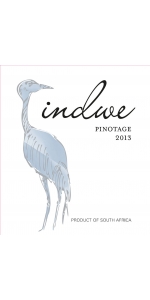Eikeboom Pinotage Western Cape 2011
| Country: | South Africa |
| Region: | Hermon |
| Winery: | Eikeboom Winery |
| Grape Type: | Pinotage |
| Vintage: | 2011 |
| Bottle Size: | 750 ml |
Indwe Pinotage Coastal Region is made from 100 percent Pinotage.
Pinotage is a true South African grape variety, Our signature grape smilar to the Blue Crane being our national bird. Indwe Pinotage grapes are meticulously sourced from our grape producers along the Coastal region of the Western Cape ensuring complexity, depth and purity of fruit. The wine is layered with sweet cherry notes, and subtle hints of mocha and vanilla flavors.
Capezzana Ghiaie Della Furbia Toscana IGT is made from Cabernet Sauvignon 40%, Syrah 35%, Merlot 25%.
In 1979 Ugo Conti Bonacossi created Ghiaie della Furba from vineyards planted among the pebble (Ghiaie) rich soils of the Furba stream. Originally planted with clippings from the famed Chateau Lafite estate in Bordeaux, the wine was made from Cabernet Sauvignon, Cabernet Franc and Merlot until the blend was changed in 1998 with the addition of Syrah. The inclusion of Cabernet Franc was slowly discontinued and today the blend includes Cabernet Sauvignon, Merlot and Syrah and is made only in the best vintages
Review:
This wine starts with pine needles and crunchy red fruit on the nose, with wet slate, cedar and tobacco leaf slowly emerging. The palate turns richer, with cherries, blackberries, dark chocolate, a little tar, coffee and sambuca. Tannins are very firm and the acid vibrant through a long finish.
-Wine Enthusiast 93 Points
All older vintage wines have been purchased from a single collectors cellar. Pictures can be requested before shipment.
All older vintage wines have been purchased from a single collectors cellar. Pictures can be requested before shipment.
Crianza is the essential wine. Balance and integrity. It displays the fine manners of experience and the grace of plethoric vine. Juicy black fruit on the palate inviting you to eat well and feel good.
But there is more. Crianza maintains an invisible pact with the landscape. An imperceptible force that brings us closer to the truth of the place. And instantly turns extreme climate vineyards into the most welcoming place in the world.
Prepared with Tempranillo grapes (100%), this wine has a very bright, intense maraschino cherry colour that fades to a Cardinal red rim.
It has a very marked aroma with a good balance of fruit and wood, where tones of vanilla intermingle with well-ripened fruit, black berries and wild fruits. There are also noticeable hints of leather and liquorice, resulting from the mingling of the French oak and the aromas inherent in this variety of grape.
In the mouth, the wine has a smooth texture but fills the palate with balanced flavours, including fine tannins, which help extend the life of the wine. The finish and aftertaste are both long and elegant.
Vineyard:
Pago de los Capellanes, Pedrosa de Duero.
Variety composition:
100% Tempranillo.
Type of soil:
Clayey and chalky.
Aging:
12 months in barrel and remainder on rack.
Type of oak:
100% French oak, medium toast.
Serving:
Uncork and decant one hour before serving at a temperature of 16-18 ºC.
Selected harvest with yields limited to 5000 kg per hectare. The harvest begins in early October, starting with the most mature parcels. Once the grapes are brought into the winery, the tanks are seeded with indigenous yeast (start culture) and the alcoholic fermentation begins. During the barrelling period, which lasts 30 days, the wine is crushed and pumped over daily, all the while controlling the density, temperature and evolution of the yeast. At the end of this fermentation, the tanks are emptied and the wine taken for malolactic fermentation.
The malolactic fermentation begins without the addition of bacteria. The temperature is held steady at 20ºC for period of 22 days, during which we monitor the levels of malic and lactic acids. When the malic acid content is less than 0.1 grams per litre, the wine is decanted to separate the lees and is transferred directly to the barrels without undergoing any type of filtration, clarification or cold treatment.
The wine is aged for twelve months in new and semi-new French oak barrels (no more than three years old). At the end of this period, it is taken to the tank for homogenisation, where it undergoes light filtration through cartridges (open pore) and is then bottled.
Review:
"A wonderfully polished expression of Ribera del Duero's match-up of power and high-plain freshness, this still has gorgeous intensity of finger-staining blackberry and mullberry succulence, a shading of expensive, fine-grained, toasty oak and satisfyingly savoury tannins all coming together to match the meat coming off the wood-fired grill. - David WILLIAMS"
- Decanter (December 14th 2022), 94 pts
Crianza is the essential wine. Balance and integrity. It displays the fine manners of experience and the grace of plethoric vine. Juicy black fruit on the palate inviting you to eat well and feel good.
But there is more. Crianza maintains an invisible pact with the landscape. An imperceptible force that brings us closer to the truth of the place. And instantly turns extreme climate vineyards into the most welcoming place in the world.
Prepared with Tempranillo grapes (100%), this wine has a very bright, intense maraschino cherry colour that fades to a Cardinal red rim.
It has a very marked aroma with a good balance of fruit and wood, where tones of vanilla intermingle with well-ripened fruit, black berries and wild fruits. There are also noticeable hints of leather and liquorice, resulting from the mingling of the French oak and the aromas inherent in this variety of grape.
In the mouth, the wine has a smooth texture but fills the palate with balanced flavours, including fine tannins, which help extend the life of the wine. The finish and aftertaste are both long and elegant.
Vineyard:
Pago de los Capellanes, Pedrosa de Duero.
Variety composition:
100% Tempranillo.
Type of soil:
Clayey and chalky.
Aging:
12 months in barrel and remainder on rack.
Type of oak:
100% French oak, medium toast.
Serving:
Uncork and decant one hour before serving at a temperature of 16-18 ºC.
Selected harvest with yields limited to 5000 kg per hectare. The harvest begins in early October, starting with the most mature parcels. Once the grapes are brought into the winery, the tanks are seeded with indigenous yeast (start culture) and the alcoholic fermentation begins. During the barrelling period, which lasts 30 days, the wine is crushed and pumped over daily, all the while controlling the density, temperature and evolution of the yeast. At the end of this fermentation, the tanks are emptied and the wine taken for malolactic fermentation.
The malolactic fermentation begins without the addition of bacteria. The temperature is held steady at 20ºC for period of 22 days, during which we monitor the levels of malic and lactic acids. When the malic acid content is less than 0.1 grams per litre, the wine is decanted to separate the lees and is transferred directly to the barrels without undergoing any type of filtration, clarification or cold treatment.
The wine is aged for twelve months in new and semi-new French oak barrels (no more than three years old). At the end of this period, it is taken to the tank for homogenisation, where it undergoes light filtration through cartridges (open pore) and is then bottled.
Eikeboom Pinotage Western Cape 2011 is made from 100 percent Pinotage
Pinotage is the result of the cross between Pinot Noir and Cinsault varieties. Pinotage was created by in South Africa in 1925 by Stellenbock University professor A.I. Perold, during experiments to develop new varieties.
The Eikeboom Pinotage tastes like a cross of Pinot Noir and Zinfandel. It has some finesse and some power all together. It is juicy, fruity, new world Rhône style fruit bomb.
The Eikeboom Winery Estate
Jannie is the 5th generation of Louws to have farmed Eikeboom (Eikeboom means “oak tree grove”), the ï¬rst being Jan Nicolaas in 1864. Known originally as de Eikenbomen, the farm has been in existence since the early 19th century, having been recorded by travellers at the time. It is beautifully situated near the small village of Hermon in the heart of the Boland, Western Cape, South Africa. The mountains, the Elandskloofberge, provide a spectacular visual backdrop.
Essentially a wheat farmer, Jannie has long had a passion for viticulture. Today he has resurrected the art of wine making as practised by his grandfather, Ou Jan ‘Ligtewyn’ whose reputation stemmed from the fact he produced a better quality vintage than normally obtained in the area at the time.
Jannie Louw is a Hobbyist winemaker. Jannie’s brother makes wine in Paarl at Baardeberg.
Production is low volume, high quality, in the garagiste style with Jannie taking meticulous care over all aspects. His range includes: Pinotage, Cabernet Sauvignon, Shiraz, Chenin Blanc and Chardonnay.
The Eikeboom Winery Vineyards
The Farm is around 900 hectares (Sheep, wheat, Cattle, and grapes.)
30 hectares of grapes. Production about 1,000 cases in total.
- back
DAOU Vineyards Soul of a Lion is made from 82% Cabernet Sauvignon, 12% Cabernet Franc, 6% Petit Verdot.
Barrel Aged: 22 months in 100% new French oak
Named for the father of Georges and Daniel Daou, Soul of a Lion is the crown jewel of DAOU, and an emblem of our quest to produce unsurpassed Cabernet Sauvignon from the terroir of DAOU Mountain.
The 2021 vintage displays remarkable intensity in the glass with dark, inky ruby-purple hues. Abundant fruit aromas of black cherry, blackberry, blueberry jam and black currant are interwoven with accents of baking spices, sage and graphite. A voluminous entry introduces sumptuous layers of chocolate-covered blueberry, tobacco, mocha, vanilla and toasted oak. The mouthfeel is concentrated and elegant, with round, vibrant tannins that carry into a commanding finish. A wine of immense staying power that will evolve favorably for many years to come.
96-98 Points by Robert Parker
Review:
Extremely dark in the glass, it starts with heavily spiced aromas of vanilla, mocha and walnut cream that balance the rich black cherry and roasted berry fruits. The palate's tannins are immensely grippy yet expertly polished, framing flavors of loam, black olive and graphite.
-Wine Enthusiast 97 Points
Siegel San Elias Carmenere is made from 100 percent Carmenere.
The nose shows beautiful red and dark fruit aromas, earthy notes and violets with balanced acidity. Supple and round in the mouth, juicy tannins, good concentration.
Pairs well with pasta dishes, Mediterranean cuisine and grilled vegetables.









